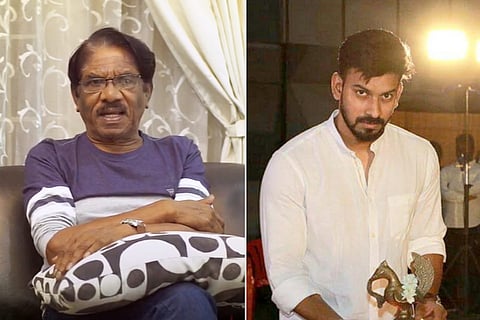

Veteran director Bharathiraja is upset with Santhosh P Jayakumar's upcoming adult horror comedy Irandam Kuthu. The teaser of the film has plenty of references to masturbation and explicit scenes, besides dialogues that are filled with innuendo. In a strongly worded letter, Bharathiraja termed the promo 'unbearable' and even asked for the government and the CBFC to step in.
Not to take the reprimand lying down, Santhosh shot back with a tweet that shows a still of Kamal Haasan with three women actors in swimsuits from the 1981 Bharathiraja film Tik Tik Tik. Santhosh asked if the director didn't find this unbearable in 1981. But even as social media users take sides on the issue, the debate is largely on whether Bharathiraja is a hypocrite or not. There is little conversation on how the female body has become an object on screen through the repeated and sustained male gaze of directors over the decades, be it in an adult or 'family' film.
In his letter, Bharathiraja says that he is no "culture police" and that he is someone who deeply appreciates any work that is made with artistry. But how has this 'artistry' translated on screen? Who has defined it?
The term 'male gaze' was coined and discussed by British feminist and film critic Laura Mulvey in her 1975 essay Visual Pleasure and Narrative Cinema. In essence, Laura argued that filmmakers, most of them male, imagined a heterosexual man as the viewer, thereby rendering the female body as an erotic object to be desired. Most Tamil films, even now, are made with cis heterosexual men in mind as the audience. In fact, when a film with a woman lead is made, it is marketed specially as a 'woman-centric' film because the norm is a male-centric film made for the star and his male fans. The women characters seldom have anything to do other than appear as the 'love interest' or are stuck in stereotypical mother/sister/vamp roles.
Women are objectified to an extent that the practice of having a scantily clad woman dancing suggestively on screen is called an 'item song', where she is an 'item', an object to be ogled and consumed, rather than a human being. From MGR's times to the present, from 'mass' filmmakers like KS Ravikumar to 'class' filmmakers like Mani Ratnam, Tamil films across decades have had such songs and lyrics that have established the female body on screen as an object.
Watch: Video of 'Kaa Karupannukum' from KS Ravikumar's Dasavatharam
Watch: Video of 'Nila Adhu Vanathumeley' from Mani Ratnam's Nayakan
Take the 'Idhu Oru Nilaa Kalam' song from Tik Tik Tik which introduces the three models played by Madhavi, Radha and Swapna. The women are introduced as objects of desire, with the camera focusing on their 'glamour' and close-up shots of bare hips being massaged. In fact, this is a common trope in horror/thriller/slasher films where the female body is used as a site for eroticism as well as violence and mutilation. The audience is supposed to be drawn to the object and then feel horrified yet voyeuristically titillated when they watch it being destroyed.
Watch: Video of 'Idhu Oru Nilaa Kalam' song from Tik Tik Tik
It's unfair to single out Bharathiraja in this respect because such depictions have been the norm for decades. 'U' rated films that have gone on to become blockbusters routinely have such scenes that are normalised. Take the 'bajji' scene from the 2019 superhit Comali, for instance. The 'comedy' track involves repeated close-up shots of a woman's hips and waist as she makes bajjis and the villain losing himself as he watches her. The film was released with a 'U' certificate and was watched widely by all sections of the audience. Meanwhile, the fetishization of a woman's navel on screen is so common that we expect to see such shots in every dance that we watch and it hardly even strikes us as objectification any more.
Several soft porn adult films have been made in Tamil cinema but these usually had a specific set of actors who would do such roles. In recent years, however, the adult film is becoming more mainstream. While films in the early 2000s like Thulluvadho Ilamai and Boys were coming-of-age dramas told firmly from a male point of view and through the male gaze, later films like Hara Hara Mahadevaki, Trisha Illana Nayanthara, Iruttu Arayil Murattu Kuththu and so on have been made and marketed as sex comedies. All of these films are made with the heterosexual male audience in mind, and are an extension of the male gaze prevalent in 'U' and 'U/A' rated fims to the adult film genre.
However, the lone adult film to emerge in Tamil, 90 ML, which was directed by a woman (Anita Udeep) and told from a female point of view, received stiff opposition from the film industry insiders as well as self-appointed guardians of morality among the public.
Our directors have a lot of unlearning to do about the male gaze before they can point fingers and call each other out for 'vulgarity'. The present outcry is over films like Irandam Kuthu crossing the 'boundaries' (which every generation of male filmmakers pushes and redraws), not the bedrock in which they emerge. Right now, it's a question of who is qualified to cast the first stone, and that is a plainly rhetorical question.